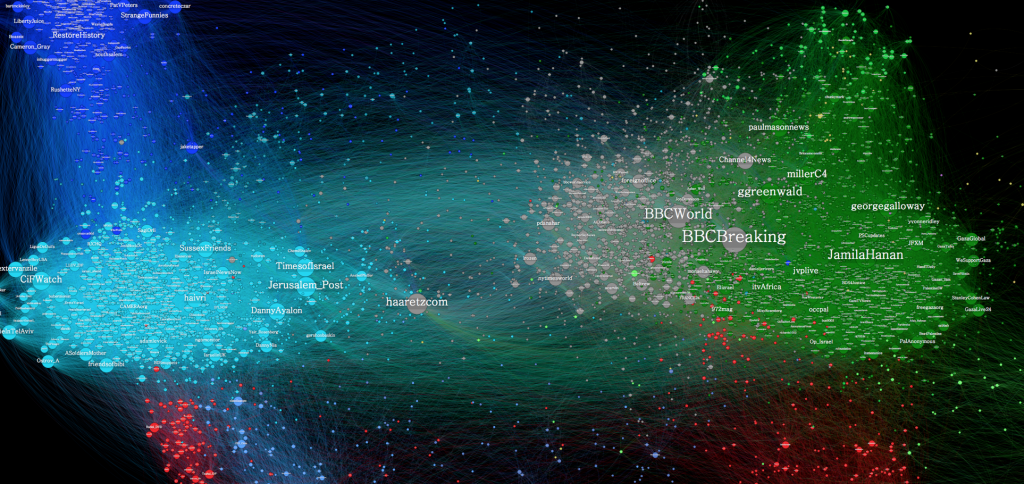Homophily
The creation of the internet and social media was supposed to connect everyone together, breaching walls created by differences in location, religion, and political beliefs. News and communication were supposed to become more widespread and help facilitate understanding among antagonistic groups. At least that was what was supposed to happen.
The availability of information has undoubtedly increased drastically. Before the internet and social media, our beliefs and knowledge were restricted to what was immediately available in the area; this may have been the local newspaper written by one source. Now with the extreme accessibility of news, one has the option of looking from the point of view of a reporter from halfway across the globe in a matter of seconds. However, the understanding and empathy that was supposed to follow has yet to be seen.
The formation of hostile divided groups is still very much present in the modern society, even on social media sites. This was clearly observed after an Israeli Air Force missile that was supposed to be targeting three Jihadists passing by a United Nations school, killed 10 and injuring a lot more in the school. The article, “Israel, Gaza, War & Data” (link provided below), included a network graph of the Twitter responses to the UNWRA school bombing. The blue nodes represent the pro-Israeli and the green pro-Palestinian; the gray is supposed to be international, and thereby should be neutral, journalists and bloggers. The network graph showed a major rift between the pro-Israeli and the pro-Palestinian sides, with the reporters residing mostly on the pro-Palestinian side. These two groups represent the major antagonism between the Israelis and the Palestinians that stretches back into history.
The rift between the Israelis and Palestinians is obvious in the graph. In social media, the problem with having two well defined groups that has very limited links in between is that members of the groups have an unfortunate side-effect of experiencing a restriction in the flow of information. Due to the lack of links in the middle, “[m]essages passed along in one side of the graph will never reach the other” (Lotan). That is a scary thought; in an era when everything is connected and when it has never been so easy to see other points of view, there is a Great Wall in the social media that binds people to their own side. This divide is partially caused by the social media sites’ suggestion algorithms that takes in what one believes and likes and then recommend more similar nodes. For example, if liked one likes the BBCWorld page on Facebook, it is very likely for BBCBreaking to show up as a suggestion; if one has a large group of friends who are pro-Israeli, then more pro-Israeli friends would show up as recommendations. (Note: for the sake of clarity, the term “friends” will include actual friends on social media along with likable pages and organizations.)
On social websites where there is no button for “enemy,” the creation of internally densely connected networks has created something that is equivalent to friend-groups and enemy-groups. Since links between friends on social media are similar to channels of communication, the existence of a complete graph among a set of nodes means that the group is very tight and information will flow freely and quickly amongst the members. However, if there is no link between two nodes, that means that there is no channel of communication that will allow for the flow of information between the two nodes. The two groups are considered “enemies” since there is a significant lack of trans-group connections between the members of the two groups.
The suggestion algorithm’s role in creating these groups that lack links between them is based on the concepts of like the Strong Triadic Closure Property. The algorithm will examine one’s friendship, establishing a network of strong ties (better friends) and network of weak ties (not a very good friend) and then suggest people with a lot of mutual friends while not making the effort to bridge the span across the groups. What makes the situation more severe is that as more and more people become affected by the suggestions of social media, the groups become more and more defined and closed off. The bigger a group gets, the more likely the group becomes closed off since the algorithm would have more “friends” (nodes in the group) to suggest and are less likely to suggest “enemies” (nodes in another group). Therefore although the suggestion feature that most social media sites have is nifty and useful, it can be considered one of the causes of the creation of isolated groups.
Source:
https://medium.com/i-data/israel-gaza-war-data-a54969aeb23e

